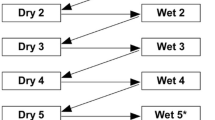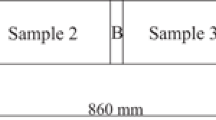Abstract
This paper presents a study of the effectiveness of cooling and steam-conditioning processes in relieving drying stresses in high-temperature dried sapwoodPinus radiata boards. An earlier-developed model of moisture movement and stress development has been modified to analyse a procedure recommended by the New Zealand Forest Research Institute. While the steaming can rapidly reduce the residual streses developed from the previous drying process, some moderate stresses may develop during the further cooling process. Cooling under cover is essential after drying, but becomes less important after steaming. The extent of steaming greatly influences the final moisture content but has a small influence on the stress level after the final cooling. Drying to a lower endpoint of moisture content and incorporation of intermediate cooling process improve the effectiveness of moisture pick-up and stress-relief during the steaming period. Instead of the recommended procedure of combined cooling and steamconditioning after drying, the numerical calculations indicate that the drying stresses could also be relieved either by simple cooling under a cover or by simple steaming without an intermediate cooling process. The use of a schedule consisting of intermittent drying and conditioning cycles is satisfactory, with the main benefit being to generate a lower moisture content after the steaming.
Zusammenfassung
Diese Arbeit beschreibt die Effektivität von Dampfkonditionieren und Abkühlen zur Spannungsentlastung in Brettern aus Kiefernsplintholz nach Hochtemperaturtrocknung. Ein zuvor entwickeltes Modell der Feuchtebewegung und Spannungsentwicklung wurde modifiziert um eine Methode des New Zealand Forest Research Institute (NZFRI) zu überprüfen. Während die Dampfbehandlung die verbleibenden Spannungen nach der Trockung rasch abbauen kann, kënnen sich während des anachliestenden Abkühlens wieder geringe Spannungen entwickeln. Nach dem Trocknen ist das Abkühlen unter Abdecken wesentlich; nach der Dampfbehandlung ist es jedoch nicht so bedeutsam. Das Ausmaß der Dämpfung beeinflußt wesentlich die Endfeuchte, hat aber geringen Einfluß auf den Spannungszustand nach Abkühlen. Trocknen zu einer niedrigeren Endfeuchte und Zwischenschalten eines Abkühlungsvorgangs verbessern die Effektivität der Trockung und Spannungentlastung. Anstelle des bisher empfohlenen Prozesses einer kombinierten Abkühlung und Dämpfung nach dem Trocknen zeigt die numerische Berechnung, daß die Spannungen einfach durch Abkühlen unter Abdeckung oder durch einfaches Dämpfen ohne Zwischenabkühlung abgebaut werden kann. Ein Trocknungsfahrplan mit abwechselnden Trocknungs-und Konditionierungszyklen ist ausreichend mit dem Hauptvorteil einer niedrigeren Endfeuchte nach der Dampfbehandlung.
Similar content being viewed by others
Abbreviations
- E :
-
Young’s modulus
- m :
-
mechano-sorptive coefficient
- t :
-
time
- T :
-
temperature
- X :
-
moisture content
- X FSP :
-
fibre saturation point
- z :
-
distance from the surface
- ε C :
-
creep strain
- ε I :
-
instantaneous strain
- ε MS :
-
mechano-sorption strain
- ε T :
-
strain due to temperature effect
- ε X :
-
free-shrinkage strain
- π:
-
wood density
- σ:
-
stress
References
Bier, H, Miller, W. R. 1990: Moisture movement, storage and handling. In: Buchanan, A. (ed): Timber Use Manual. NZ Timber Industry Federation, Wellington, New Zealand
Carrington, A.M. 1996: High-temperature seasoning of softwood boards: determination of mechanical properties at elevated temperatures. ME Thesis, Department of Chemical and Process Engineering, University of Canterbury, New Zealand
Chen, G.; Keey, R.B.; Walker, J.C.F. 1996a: Mosture content profiles in sapwood boards on drying. Proceedings of 10th International Drying Symposium (IDS96), Krakow, Poland, Vol. A., pp 679–687
Chen, G.; Keey, R.B.; Walker, J.C.F. 1996b: Stress development and permeability variation on drying sapwood above fibre saturation. Proceedings of 5th IUFRO Drying Conference, Quebec, Canada, pp. 455–461
Chen, G.;Keey, R.B.;Walker, J.C.F.. 1997a: The drying stress and check development of high-temperature kiln seasoning of sapwoodPinus radiata boards—Part I: Moisture movement and strain model. Holz Roh-Werkstoff 55: 59–64
Chen, G.;Keey, R.B.;Walker, J.C.F. 1997b: The drying stress and check development on high-temperature kiln seasoning of sapwoodPinus radiata boards—Part II: Stress development. Holz Roh-Werkstoff 55: 169–173
Forest Products Laboratory, USDA. 1987: “Handbook of wood and wood-based materials for engineers, architects and builders”. Hemisphere Publishing Co., New York
Haslett, A.N.;Simpson, I. 1991: Final steaming critical to HT drying of appearance-grade timber. NZ Forest Industries, (9): 40–41.
Hisada, T. 1986: Creep and set behaviour of wood relating to kiln drying. (In Japaneses), Bull. Fort. & Fort. Prod. Res. Inst. 335: 31–130
Keey, R.B. 1978: “Introduction to industrial drying operations,” Pergamon Press Oxford
Langrish, T.A.G.;Keey, R.B.;Kumar, M. 1992: Improving the quality of timber from Red Beech (N. fusca) by intermittent Drying, Drying Technology, 10(4): 947–960.
New Zealand Ministry of Forestry; New Zealand Forest Research Institute, 1996: “Producing quality kiln-dired timber in New Zealand”
Pang, S.;Langrish T.A.G.;Keey, R.B. 1994: Moisture movement in softwood timber at elevated temperatures. Drying Technology, 12(8): 1897–1914
Pratt, G.H. 1974: “Timber drying manual.” Building Research Establishment, London
Ranta-Maunus, A. 1993: Rheological behaviour of wood in directions perpendicular to the grain. Material and Structures. 26: 362–369
Schniewind, A.P. 1989: “Concise encyclopedia of wood and wood-based materials.” Pergamon Press, Oxford
Stanish, M.A.;Schajer, G.S.;Kayihan, F. 1986: A mathematical model of drying for hygroscopic porous media. AIChemEJournal, 32(8): 1301–1311
Williams, D.H.; Kininmonth, J.A. 1984: High-temperature kiln drying of radiata pine sawn timber, NZFRI Bulletin No 73
Wu, Q;Milota, M.R. 1995: Rheological behaviour of Douglas-fir at elevated temperature. Wood and Fibre, 27(3): 285–295
Wu, Q. Milota, M.R. 1996: Mechano-sorptive deformation of Douglas-fir under tangential tensile stress during moisture adsorption. Wood and Fibre, 28(1): 128–132.
Author information
Authors and Affiliations
Additional information
This work is supported by a research grant from the New Zealand Foundation for Research, Science and Technology (UOC Contract 501). The computer facilities were provided by the Department of Chemical and Process Engineering, University of Canterbury, and the Department of Physics, University of Otago. The authors would like to thank Mr. A.N. Haslett of NZFRI for his advice on the operation of NZFRI drying schedules.
Rights and permissions
About this article
Cite this article
Chen, G., Keey, R.B. & Walker, J.C.F. Stress relief for sapwoodPinus radiata boards by cooling and steam-conditioning processes. Holz als Roh- und Werkstoff 55, 351–360 (1997). https://doi.org/10.1007/s001070050246
Issue Date:
DOI: https://doi.org/10.1007/s001070050246




